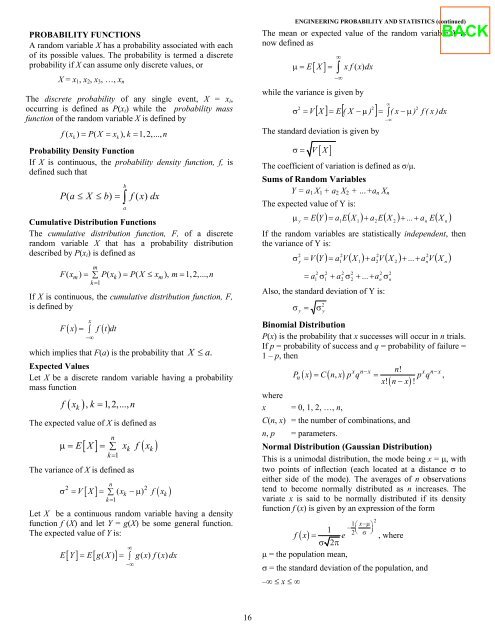fundamentals of engineering supplied-reference handbook - Ventech!
fundamentals of engineering supplied-reference handbook - Ventech!
fundamentals of engineering supplied-reference handbook - Ventech!
You also want an ePaper? Increase the reach of your titles
YUMPU automatically turns print PDFs into web optimized ePapers that Google loves.
PROBABILITY FUNCTIONS<br />
A random variable X has a probability associated with each<br />
<strong>of</strong> its possible values. The probability is termed a discrete<br />
probability if X can assume only discrete values, or<br />
X = x1, x2, x3, …, xn<br />
The discrete probability <strong>of</strong> any single event, X = xi,<br />
occurring is defined as P(xi) while the probability mass<br />
function <strong>of</strong> the random variable X is defined by<br />
f k<br />
k<br />
( x ) = P(<br />
X = x ), k = 1, 2, ..., n<br />
Probability Density Function<br />
If X is continuous, the probability density function, f, is<br />
defined such that<br />
P ( a ≤ X ≤ b)<br />
= f ( x)<br />
dx<br />
b<br />
∫<br />
a<br />
Cumulative Distribution Functions<br />
The cumulative distribution function, F, <strong>of</strong> a discrete<br />
random variable X that has a probability distribution<br />
described by P(xi) is defined as<br />
m<br />
m<br />
∑<br />
k=<br />
1<br />
k m<br />
F( x ) = P( x ) = P( X ≤ x ), m= 1,2,..., n<br />
If X is continuous, the cumulative distribution function, F,<br />
is defined by<br />
x<br />
( ) = ∫ ( )<br />
F x f t dt<br />
−∞<br />
which implies that F(a) is the probability that X ≤ a.<br />
Expected Values<br />
Let X be a discrete random variable having a probability<br />
mass function<br />
f ( x ), k = 1,2,..., n<br />
k<br />
The expected value <strong>of</strong> X is defined as<br />
n<br />
[ ] ( )<br />
µ= E X = ∑ x f x<br />
k=<br />
1<br />
The variance <strong>of</strong> X is defined as<br />
k k<br />
n<br />
2 2<br />
V X xk f xk<br />
k=<br />
1<br />
[ ] ∑ ( ) ( )<br />
σ = = −µ<br />
Let X be a continuous random variable having a density<br />
function f (X) and let Y = g(X) be some general function.<br />
The expected value <strong>of</strong> Y is:<br />
[ ] [ ]<br />
E Y = E g( X) = ∫ g( x) f( x) dx<br />
∞<br />
−∞<br />
16<br />
ENGINEERING PROBABILITY AND STATISTICS (continued)<br />
The mean or expected value <strong>of</strong> the random variable X is<br />
now defined as<br />
∞<br />
µ= E[ X] = ∫ xf( x) dx<br />
−∞<br />
while the variance is given by<br />
∞<br />
2<br />
[ X ] = E[<br />
( X − µ ) ] = ∫<br />
2<br />
2<br />
σ = V<br />
( x − µ ) f ( x ) dx<br />
The standard deviation is given by<br />
σ=<br />
V[ X]<br />
−∞<br />
The coefficient <strong>of</strong> variation is defined as σ/µ.<br />
Sums <strong>of</strong> Random Variables<br />
Y = a1 X1 + a2 X2 + …+an Xn<br />
The expected value <strong>of</strong> Y is:<br />
( Y ) = a E(<br />
X ) + a E(<br />
X ) + ... a E(<br />
X )<br />
µ y =<br />
1 1 2 2<br />
E +<br />
If the random variables are statistically independent, then<br />
the variance <strong>of</strong> Y is:<br />
σ<br />
2<br />
y<br />
= V<br />
2<br />
2<br />
2<br />
( Y ) = a V ( X ) + a V ( X ) + ... + a V ( X )<br />
1<br />
= a σ + a σ + ... + a σ<br />
2 2 2 2<br />
2 2<br />
1 1 2 2<br />
n n<br />
Also, the standard deviation <strong>of</strong> Y is:<br />
σ<br />
y<br />
=<br />
σ<br />
2<br />
y<br />
1<br />
Binomial Distribution<br />
P(x) is the probability that x successes will occur in n trials.<br />
If p = probability <strong>of</strong> success and q = probability <strong>of</strong> failure =<br />
1 – p, then<br />
x n−x n!<br />
x n−x Pn ( x) = Cnxpq ( , ) = pq ,<br />
x! ( n−x) !<br />
where<br />
x = 0, 1, 2, …, n,<br />
C(n, x) = the number <strong>of</strong> combinations, and<br />
n, p = parameters.<br />
Normal Distribution (Gaussian Distribution)<br />
This is a unimodal distribution, the mode being x = µ, with<br />
two points <strong>of</strong> inflection (each located at a distance σ to<br />
either side <strong>of</strong> the mode). The averages <strong>of</strong> n observations<br />
tend to become normally distributed as n increases. The<br />
variate x is said to be normally distributed if its density<br />
function f (x) is given by an expression <strong>of</strong> the form<br />
1<br />
f ( x) = e<br />
σ 2π<br />
µ = the population mean,<br />
2<br />
2<br />
1⎛<br />
x−µ<br />
⎞<br />
− ⎜ ⎟<br />
2⎝<br />
σ ⎠<br />
2<br />
, where<br />
σ = the standard deviation <strong>of</strong> the population, and<br />
–∞ ≤ x ≤ ∞<br />
n<br />
n<br />
n<br />
n
















